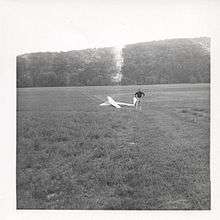Schempp-Hirth Standard Austria
| Standard Austria | |
|---|---|
 | |
| Role | Glider |
| National origin | Austria |
| Manufacturer | Schempp-Hirth (licensed prod after 14 built in Austria) |
| Designer | Rüdiger Kunz |
| First flight | July 1959[1] |
| Number built | 81[1] |
|
| |
The Standard Austria was a single-seat aerobatic glider that was originally designed and built in Austria from 1959 but production was moved in 1962 to Schempp-Hirth in Germany.
Development
Commissioned by the Österreichischer Aeroclub – (Austrian Aero club) the Standard Austria was designed by Rüdiger Kunz to compete in the 1960 OSTIV competition for a standard class sailplane, winning plaudits as the best standard class aircraft.[2] The design aims were to produce an aircraft with a low wing loading and a high lift/drag ratio, which necessitated low weight and low drag. To achieve the design aims the Standard Austria was constructed primarily of wood with plywood skinning and a glass-fibre nose section, pilots seat and tail-cone. Other weight and drag saving measures included use of an all-moving 'V' or 'Butterfly' tail unit with two surfaces, set in a 'V' configuration, providing stability and control in both pitch and yaw, in exchange for increased cost and complexity of the control systems and minor handling side effects, like slight pitching of the aircraft with application of rudder and vice versa.
After the initial production run in Austria, production was moved to Schempp-Hirth in Germany, where the Standard Austria's development continued with improved and heavier models, optional retractable undercarriage, replacement of the NACA section wings with wings using an Eppler 266 section,[2] to improve low-speed performance.


Two were used in the 1967 NFB film 'Flight' (CF-RNH, CF-RSO).
Variants
- Standard Austria
- Initial production model built in Austria.
- Standard Austria S
- Production aircraft built by Schemp-Hirth under license in Germany.
- Standard Austria SH
- Improved heavier model, 5 built.
- Standard Austria SH-I
- The SH with retractable undercarriage
- Standard Austria
- From 1964 produced using an Eppler 266 aerofoil section.
The Schempp-Hirth SHK, a 17-meter Open Class glider, was also developed by Klaus Holighaus in 1965 from the SH-1.
Specifications (Standard Austria)
Data from The World's Sailplanes:Die Segelflugzeuge der Welt:Les Planeurs du Monde Volume II[3]
General characteristics
- Crew: 1
- Length: 6.2 m (20 ft 4 in)
- Wingspan: 15 m (49 ft 3 in)
- Wing area: 13.5 m2 (145 sq ft)
- Aspect ratio: 16.7
- Airfoil: NACA 652 415
- Empty weight: 205 kg (452 lb)
- Gross weight: 323 kg (712 lb)
Performance
- Stall speed: 55 km/h (34 mph; 30 kn)
- Never exceed speed: 250 km/h (155 mph; 135 kn)
- Rough air speed max: 140 km/h (87.0 mph; 75.6 kn)
- Aerotow speed: 140 km/h (87.0 mph; 75.6 kn)
- Winch launch speed: 95 km/h (59.0 mph; 51.3 kn)
- Terminal velocity: with full airbrakes 250 km/h (155 mph; 135 kn)
- g limits: +8 -0 at 230 km/h (142.9 mph; 124.2 kn)
- Maximum glide ratio: 34 at 105 km/h (65.2 mph; 56.7 kn)
- Rate of sink: 0.7 m/s (140 ft/min) at 70 km/h (43.5 mph; 37.8 kn)
- Wing loading: 24 kg/m2 (4.9 lb/sq ft)
See also
- Related development
- Aircraft of comparable role, configuration and era
- Related lists
References
- 1 2 http://www.sailplanedirectory.com/PlaneDetails.cfm?planeID=338
- 1 2 http://www.sailplanedirectory.com/schempp.htm
- ↑ Shenstone, B.S.; K.G. Wilkinson (1963). The World's Sailplanes:Die Segelflugzeuge der Welt:Les Planeurs du Monde Volume II (in English, French, and German) (1st ed.). Zurich: Organisation Scientifique et Technique Internationale du Vol a Voile (OSTIV) and Schweizer Aero-Revue. pp. 34–36.
- Shenstone, B.S.; K.G. Wilkinson (1963). The World's Sailplanes:Die Segelflugzeuge der Welt:Les Planeurs du Monde Volume II (in English, French, and German) (1st ed.). Zurich: Organisation Scientifique et Technique Internationale du Vol a Voile (OSTIV) and Schweizer Aero-Revue. pp. 34–36.
- Taylor, J. H. (ed) (1989) Jane's Encyclopedia of Aviation. Studio Editions: London. p. 29
- Coates, Andrew. “Jane's World Sailplanes & Motor Gliders new edition”. London, Jane's. 1980. ISBN 0-7106-0017-8
External links
| Wikimedia Commons has media related to Schempp-Hirth. |
- http://www.sailplanedirectory.com/schempp.htm
- Martin Schempp
- http://www.sailplanedirectory.com/PlaneDetails.cfm?planeID=338
- British Gliding Association - Standard Austria data sheet